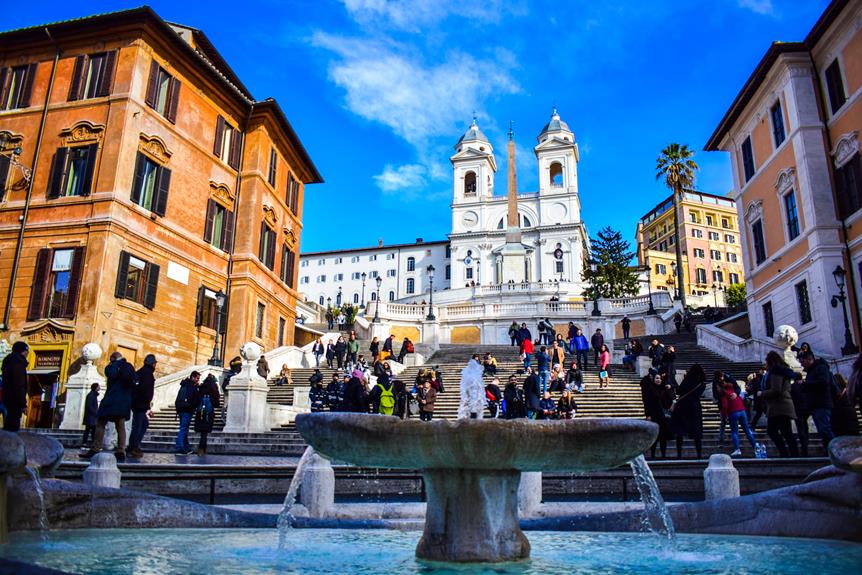Hey there! Did you know that the Algarve region in Portugal is home to a plethora of fascinating historical landmarks? Well, let me be your guide as we embark on a journey through the rich history of Algarve's historical treasures.
In 'Exploring Algarve's Historical Landmarks: A Step-By-Step Guide,' I'll take you on a captivating adventure, uncovering the secrets of ancient ruins, medieval castles, historic churches, fascinating fortresses, and museums that showcase Algarve's captivating past.
With detailed information on each landmark's significance and unique attractions, as well as recommendations for guided tours and water activities, this guide is designed to serve your every need.
So, let's dive in and discover the captivating history of the Algarve region together!
Key Takeaways
- The Algarve region in Portugal is rich in historical landmarks, including Roman ruins, medieval castles, historic churches, and fascinating fortresses.
- Some notable historical sites in the Algarve include the Nossa Senhora da Assunção Convent, Ponta da Piedade Lighthouse, Silves Castle, and Sagres Fortress.
- The region's churches and chapels, such as the Carmo Church and Igreja de Sao Lourenco de Almancil, are known for their stunning architecture and artwork.
- Museums like Loulé Museum and Igreja do Carmo in Tavira offer a glimpse into the region's history through ancient artifacts and baroque interiors.
Roman Ruins in Algarve
I've visited three remarkable Roman ruins in Algarve that showcase the region's rich ancient history. The first one is the Nossa Senhora da Assunção Convent in Faro. This convent, which is now Algarve's main museum, houses a collection of Roman busts and a stunning Roman mosaic. It's a fascinating glimpse into the past and a must-visit for history enthusiasts.
Next, we've the Ponta da Piedade Lighthouse. While not a Roman ruin per se, it offers a lovely walk along the coastline and provides a unique perspective on the region's ancient past. As you stroll from Porto De Mos to the lighthouse, you'll be surrounded by the breathtaking beauty of the Ria Formosa Natural Park.
Lastly, there's the Igreja de Santo António. Built in 1707, this church was rebuilt after the devastating 1755 earthquake. It now houses a museum with archaeological pieces and sacred art, allowing visitors to delve into the fascinating history of the region.
Now that we've explored the Roman ruins, let's move on to the medieval castles that await our discovery.
Medieval Castles to Explore
Now, let's delve into the captivating world of medieval castles that await exploration in the Algarve region. From Silves Castle, the largest and best-preserved ancient monument in the area, to Sagres Fortress, which served as a school of navigation, the Algarve is a treasure trove of historical wonders. Here are three castles that you shouldn't miss:
- Silves Castle: Explore the impressive walls and towers of this medieval fortress and immerse yourself in its rich history. Don't forget to visit during the week-long medieval fair in August for an even more authentic experience.
- Sagres Fortress: Discover the legacy of Prince Henry the Navigator at this European Heritage site. Marvel at the enormous wind compass and learn about the important role this fortress played in maritime exploration.
- Castro Marim Castle: Enjoy breathtaking views of the nature reserve and Spain from this 13th-century castle. Be sure to visit during the medieval fair in August for a taste of the past.
Now that we've explored the medieval castles, let's move on to the next section and discover the historic churches and chapels of the Algarve.
Historic Churches and Chapels
As we continue our exploration of Algarve's historical landmarks, let's delve into the fascinating world of its historic churches and chapels. The Algarve region is home to a rich collection of religious sites, each with its own unique architectural and artistic features. In the Old Town and historic centre of Algarve, you will find several remarkable churches and chapels that have stood the test of time. Take a look at the table below for a glimpse into some of these awe-inspiring places of worship:
| Church/Chapel | Notable Features | Location |
|---|---|---|
| Carmo Church | Stark contrast between opulent ornamentation and humble lives of worshippers centuries ago | Algarve Old Town |
| Igreja de Sao Lourenco de Almancil | Stunning hand-painted blue and white azulejos, lavishly decorated gold altar | Algarve Historic Centre |
| Igreja de São Lourenço | Intricate blue and white hand-painted azulejos adorning the interior of the church | Algarve Historic Centre |
| Igreja de Santo António | Rich baroque interior with ornate retables, ceiling paintings, and tile panels | Algarve Old Town |
| Igreja do Carmo | Rich baroque interior and a chapel adorned with human bones and skulls | Algarve Historic Centre |
These churches and chapels not only serve as important religious sites, but they also offer glimpses into the region's history and cultural heritage. Visiting them allows you to appreciate the architectural marvels and artistic treasures that have been carefully preserved throughout the centuries. So, make sure to include these historic landmarks in your Algarve itinerary to experience the spiritual and cultural richness they have to offer.
Fascinating Fortresses in Algarve
Let's begin our exploration of Algarve's historical landmarks by delving into the fascinating fortresses that dot the region's landscape. These fortresses not only showcase the rich history of the area but also offer breathtaking views of the surrounding scenery.
Here are three notable fortresses in Algarve:
- Sagres Fortress: Built by Prince Henry the Navigator in 1453, this fortress was once a renowned school of navigation. Today, it houses a small museum that provides insights into the region's maritime past.
- Silves Castle: Considered the most significant Moorish building in Portugal, this fortress hosts a week-long medieval fair in August. Visitors can explore its impressive walls and towers and marvel at the stunning views of the city.
- Loulé Castle: Built in the 13th century, this fortress now serves as the main branch of the Loulé Museum. Its clock tower is a notable feature, and the baroque interior of the castle is a sight to behold.
These fortresses aren't just historical landmarks but also provide a glimpse into the region's cultural heritage.
Museums Showcasing Algarve's History
I will take you on a journey through the museums that showcase the rich history of Algarve. One of the main museums is the Nossa Senhora da Assunção Convent in Faro. This museum houses a collection of Roman busts, a Roman mosaic, and Visigothic plaques, providing a glimpse into the region's ancient past. Another significant museum is the Loulé Museum, located in Loulé Castle. Here, you can explore ancient artifacts and even step into a recreated medieval kitchen. The town of Tavira is home to the Igreja do Carmo, a church that features a baroque interior and a chapel adorned with human bones and skulls. Lastly, don't miss the Faro Cathedral, which offers a panoramic view over the city and the stunning Ria Formosa Natural Park. Take a stroll along the coastal path and discover the rich history of Algarve through these captivating museums.
| Museum | Location | Highlights |
|---|---|---|
| Nossa Senhora da Assunção Convent | Faro | Roman busts, Roman mosaic, Visigothic plaques |
| Loulé Museum | Loulé Castle | Ancient artifacts, medieval kitchen |
| Igreja do Carmo | Tavira | Baroque interior, chapel with human bones and skulls |
| Faro Cathedral | Faro | Panoramic view over the city, Ria Formosa Natural Park |
Frequently Asked Questions
How Do You Explore the Algarve?
To explore the Algarve, you can uncover hidden gems, indulge in local cuisine, and enjoy outdoor activities. It's all about immersing yourself in the rich history, breathtaking landscapes, and vibrant culture of this beautiful region.
How Many Days in Algarve Is Enough?
Spending 3-5 days in Algarve is ideal for exploring its historical landmarks. You must visit attractions like the Old Town Faro and Carvoeiro Boardwalk. Don't forget to explore off the beaten path for hidden gems!
What Does Algarve Mean in Portuguese?
Algarve, meaning 'the West' in Portuguese, is a region in southern Portugal. It reflects the historical influences of Arabic culture and is known for its stunning coastline and historical landmarks.
What Is the History of the Algarve?
The history of the Algarve is fascinating. From the Moorish architecture of Silves Castle to the navigation school at Sagres Fortress, there are so many historical landmarks to explore. Here are some tips for exploring Algarve's historical landmarks.
Conclusion
After immersing myself in the rich history of the Algarve region, I can confidently say that exploring its historical landmarks is an absolute must for any adventurer.
From the awe-inspiring Roman ruins to the majestic medieval castles, each site offers a glimpse into the captivating past of this enchanting region.
The historic churches, fascinating fortresses, and enlightening museums further deepen the appreciation for Algarve's cultural heritage.
So grab a guidebook, lace up your walking shoes, and embark on a journey through time in the remarkable Algarve.



